1. Alberti KG, Eckel RH, Grundy SM, Zimmet PZ, Cleeman JI, Donato KA, Fruchart JC, James WP, Loria CM, Smith SC Jr. International Diabetes Federation Task Force on Epidemiology and Prevention. National Heart, Lung, and Blood Institute. American Heart Association. World Heart Federation. International Atherosclerosis Society. International Association for the Study of Obesity. Harmonizing the metabolic syndrome: a joint interim statement of the International Diabetes Federation Task Force on Epidemiology and Prevention; National Heart, Lung, and Blood Institute; American Heart Association; World Heart Federation; International Atherosclerosis Society; and International Association for the Study of Obesity. Circulation. 2009; 120:1640–1645. PMID:
19805654.
2. Expert Panel on Detection, Evaluation, and Treatment of High Blood Cholesterol in Adults. Executive summary of the third report of the National Cholesterol Education Program (NCEP) Expert Panel on Detection, Evaluation, and Treatment of High Blood Cholesterol in Adults (Adult Treatment Panel III). JAMA. 2001; 285:2486–2497. PMID:
11368702.
3. Eddy DM, Schlessinger L, Heikes K. The metabolic syndrome and cardiovascular risk: implications for clinical practice. Int J Obes. 2008; 32 Suppl 2:S5–10.

5. Ranasinghe P, Mathangasinghe Y, Jayawardena R, Hills AP, Misra A. Prevalence and trends of metabolic syndrome among adults in the Asia-Pacific region: a systematic review. BMC Public Health. 2017; 17:101. PMID:
28109251.

6. Korean Statistical Information Service. National Health Examinations Statistics [Internet]. Wonju: National Health Insurance Service;2019. cited 2019 August 28. Available from:
http://kosis.kr/index/index.do.
7. O'Neill S, O'Driscoll L. Metabolic syndrome: a closer look at the growing epidemic and its associated pathologies. Obes Rev. 2015; 16:1–12.
8. McKeown NM, Meigs JB, Liu S, Wilson PW, Jacques PF. Whole-grain intake is favorably associated with metabolic risk factors for type 2 diabetes and cardiovascular disease in the Framingham Offspring Study. Am J Clin Nutr. 2002; 76:390–398. PMID:
12145012.

9. Shin JY, Kim JY, Kang HT, Han KH, Shim JY. Effect of fruits and vegetables on metabolic syndrome: a systematic review and meta-analysis of randomized controlled trials. Int J Food Sci Nutr. 2015; 66:416–425. PMID:
25945735.

10. Lee CJ, Joung H. Milk intake is associated with metabolic syndrome -using data from the Korea National Health and Nutrition Examination Survey 2007~2010. Korean J Community Nutr. 2012; 17:795–804.
11. Hong S, Song Y, Lee KH, Lee HS, Lee M, Jee SH, Joung H. A fruit and dairy dietary pattern is associated with a reduced risk of metabolic syndrome. Metabolism. 2012; 61:883–890. PMID:
22209672.

12. Jun S, Ha K, Chung S, Joung H. Meat and milk intake in the rice-based Korean diet: impact on cancer and metabolic syndrome. Proc Nutr Soc. 2016; 75:374–384. PMID:
26975473.

13. Kim Y, Je Y. Meat consumption and risk of metabolic syndrome: results from the Korean population and a meta-analysis of observational studies. Nutrients. 2018; 10:E390. PMID:
29565803.

14. Rhee MY, Kim JH, Kim YS, Chung JW, Bae JH, Nah DY, Kim YK, Lee MM, Lim CY, Byun JE, Park HK, Kang BW, Kim JW, Kim SW. High sodium intake in women with metabolic syndrome. Korean Circ J. 2014; 44:30–36. PMID:
24497887.

15. Riccardi G, Giacco R, Rivellese AA. Dietary fat, insulin sensitivity and the metabolic syndrome. Clin Nutr. 2004; 23:447–456. PMID:
15297079.

16. Kim YJ, Hwang JY, Kim H, Park S, Kwon O. Diet quality, physical activity, and their association with metabolic syndrome in Korean adults. Nutrition. 2019; 59:138–144. PMID:
30471526.

17. DeSalvo KB, Olson R, Casavale KO. Dietary Guidelines for Americans. JAMA. 2016; 315:457–458. PMID:
26746707.

18. Hercberg S, Chat-Yung S, Chaulia M. The French National Nutrition and Health Program: 2001-2006-2010. Int J Public Health. 2008; 53:68–77. PMID:
18681335.

19. Fogli-Cawley JJ, Dwyer JT, Saltzman E, McCullough ML, Troy LM, Meigs JB, Jacques PF. The 2005 Dietary Guidelines for Americans and risk of the metabolic syndrome. Am J Clin Nutr. 2007; 86:1193–1201. PMID:
17921402.

20. Kesse-Guyot E, Fezeu L, Galan P, Hercberg S, Czernichow S, Castetbon K. Adherence to French nutritional guidelines is associated with lower risk of metabolic syndrome. J Nutr. 2011; 141:1134–1139. PMID:
21490288.
21. Jung HJ, Han SN, Song S, Paik HY, Baik HW, Joung H. Association between adherence to the Korean Food Guidance System and the risk of metabolic abnormalities in Koreans. Nutr Res Pract. 2011; 5:560–568. PMID:
22259682.

22. Al Thani M, Al Thani AA, Al-Chetachi W, Al Malki B, Khalifa SA, Bakri AH, Hwalla N, Naja F, Nasreddine L. Adherence to the Qatar dietary guidelines: a cross-sectional study of the gaps, determinants and association with cardiometabolic risk amongst adults. BMC Public Health. 2018; 18:503. PMID:
29661175.

23. Hosseini-Esfahani F, Jessri M, Mirmiran P, Bastan S, Azizi F. Adherence to dietary recommendations and risk of metabolic syndrome: Tehran Lipid and Glucose Study. Metabolism. 2010; 59:1833–1842. PMID:
20667561.

24. Lassale C, Galan P, Julia C, Fezeu L, Hercberg S, Kesse-Guyot E. Association between adherence to nutritional guidelines, the metabolic syndrome and adiposity markers in a French adult general population. PLoS One. 2013; 8:e76349. PMID:
24124548.

25. Choo J, Yoon SJ, Ryu H, Park MS, Lee HS, Park YM, Lim DS. The Seoul Metropolitan lifestyle intervention program and metabolic syndrome risk: a retrospective database study. Int J Environ Res Public Health. 2016; 13:E667. PMID:
27384576.

26. Lee YH, Yoon SJ, Kim HS, Oh SW, Ryu HS, Choo JA, Kim SN, Kim YA, Park MS, Park YS, Kim SY, Kwon AR. Design and preliminary results of a metropolitan lifestyle intervention program for people with metabolic syndrome in South Korea. Diabetes Res Clin Pract. 2013; 101:293–302. PMID:
23849812.

27. Metabolic Syndrome Management Center of Seoul Metropolitan Government. The Seoul Metabolic Syndrome Management program [Internet]. Seoul: Metabolic Syndrome Management Center of Seoul Metropolitan Government;2010. cited 2018 June 30. Available from:
http://5check.or.kr/eng/eng_main.html.
28. Park MS, Park YS, Kim SY, Park S, Seol HM, Woo S, Cho S, Lim DS. Introduction and effectiveness of the Seoul Metabolic Syndrome Management. Public Health Aff. 2017; 1:25–39.

29. Trinder P. Determination of glucose in blood using glucose oxidase with an alternative oxygen acceptor. Ann Clin Biochem. 1969; 6:24–27.

30. Lee S, Park HS, Kim SM, Kwon HS, Kim DY, Kim DJ, Cho GJ, Han JH, Kim SR, Park CY, Oh SJ, Lee CB, Kim KS, Oh SW, Kim YS, Choi WH, Woo HJ. Cut-off points of waist circumference for defining abdominal obesity in the Korean population. Korean J Obes. 2006; 15:1–9.
31. Paik HY, Kim CI, Moon HK, Yoon JS, Joung H, Shim JE, Jung HJ. 2008 Dietary Goals and Dietary Guidelines for Korean Adults. Korean J Nutr. 2008; 41:887–899.
32. Fogelholm M, Malmberg J, Suni J, Santtila M, Kyröläinen H, Mäntysaari M, Oja P. International physical activity questionnaire: validity against fitness. Med Sci Sports Exerc. 2006; 38:753–760. PMID:
16679993.
33. Craig CL, Marshall AL, Sjöström M, Bauman AE, Booth ML, Ainsworth BE, Pratt M, Ekelund U, Yngve A, Sallis JF, Oja P. International physical activity questionnaire: 12-country reliability and validity. Med Sci Sports Exerc. 2003; 35:1381–1395. PMID:
12900694.

34. Hosmer DW, Lemeshow S. Applied logistic regression. New York (NY): Wiley;2000.
35. Kim HJ, Choi I, Kim WG, Asano K, Hong J, Cho YM, Yoon J. Effect of a worksite-based dietary intervention program for the management of metabolic syndrome. Korean J Community Nutr. 2016; 21:237–246.

36. Bo S, Ciccone G, Baldi C, Benini L, Dusio F, Forastiere G, Lucia C, Nuti C, Durazzo M, Cassader M, Gentile L, Pagano G. Effectiveness of a lifestyle intervention on metabolic syndrome. A randomized controlled trial. J Gen Intern Med. 2007; 22:1695–1703. PMID:
17922167.

37. Aucott L, Gray D, Rothnie H, Thapa M, Waweru C. Effects of lifestyle interventions and long-term weight loss on lipid outcomes - a systematic review. Obes Rev. 2011; 12:e412–25. PMID:
21371252.

38. Ma Y, Olendzki BC, Wang J, Persuitte GM, Li W, Fang H, Merriam PA, Wedick NM, Ockene IS, Culver AL, Schneider KL, Olendzki GF, Carmody J, Ge T, Zhang Z, Pagoto SL. Single-component versus multicomponent dietary goals for the metabolic syndrome: a randomized trial. Ann Intern Med. 2015; 162:248–257. PMID:
25686165.
39. Mensink M, Blaak EE, Corpeleijn E, Saris WH, de Bruin TW, Feskens EJ. Lifestyle intervention according to general recommendations improves glucose tolerance. Obes Res. 2003; 11:1588–1596. PMID:
14694225.

40. Pettman TL, Buckley JD, Misan GM, Coates AM, Howe PR. Health benefits of a 4-month group-based diet and lifestyle modification program for individuals with metabolic syndrome. Obes Res Clin Pract. 2009; 3:221–235. PMID:
24973150.

41. Baudrand R, Campino C, Carvajal CA, Olivieri O, Guidi G, Faccini G, Vöhringer PA, Cerda J, Owen G, Kalergis AM, Fardella CE. High sodium intake is associated with increased glucocorticoid production, insulin resistance and metabolic syndrome. Clin Endocrinol (Oxf). 2014; 80:677–684. PMID:
23594269.

42. Räisänen JP, Silaste ML, Kesäniemi YA, Ukkola O. Increased daily sodium intake is an independent dietary indicator of the metabolic syndrome in middle-aged subjects. Ann Med. 2012; 44:627–634. PMID:
21679102.

43. Oh HY, Kim MK, Lee M, Kim YO. Macronutrient composition and sodium intake of diet are associated with risk of metabolic syndrome and hypertension in Korean women. PLoS One. 2013; 8:e78088. PMID:
24205105.

44. Lee WJ, Kim HC, Oh SM, Choi DP, Cho J, Suh I. Factors associated with a low-sodium diet: the Fourth Korean National Health and Nutrition Examination Survey. Epidemiol Health. 2013; 35:e2013005. PMID:
23807908.

45. Hong JW, Noh JH, Kim DJ. Factors associated with high sodium intake based on estimated 24-hour urinary sodium excretion: the 2009–2011 Korea National Health and Nutrition Examination Survey. Medicine (Baltimore). 2016; 95:e2864. PMID:
26945369.
46. Schroeder N, Park YH, Kang MS, Kim Y, Ha GK, Kim HR, Yates AA, Caballero B. A randomized trial on the effects of 2010 Dietary Guidelines for Americans and Korean diet patterns on cardiovascular risk factors in overweight and obese adults. J Acad Nutr Diet. 2015; 115:1083–1092. PMID:
26115560.

47. Song Y, Joung H. A traditional Korean dietary pattern and metabolic syndrome abnormalities. Nutr Metab Cardiovasc Dis. 2012; 22:456–462. PMID:
21215606.

48. Lee KW, Cho MS. The traditional Korean dietary pattern is associated with decreased risk of metabolic syndrome: findings from the Korean National Health and Nutrition Examination Survey, 1998–2009. J Med Food. 2014; 17:43–56. PMID:
24456354.

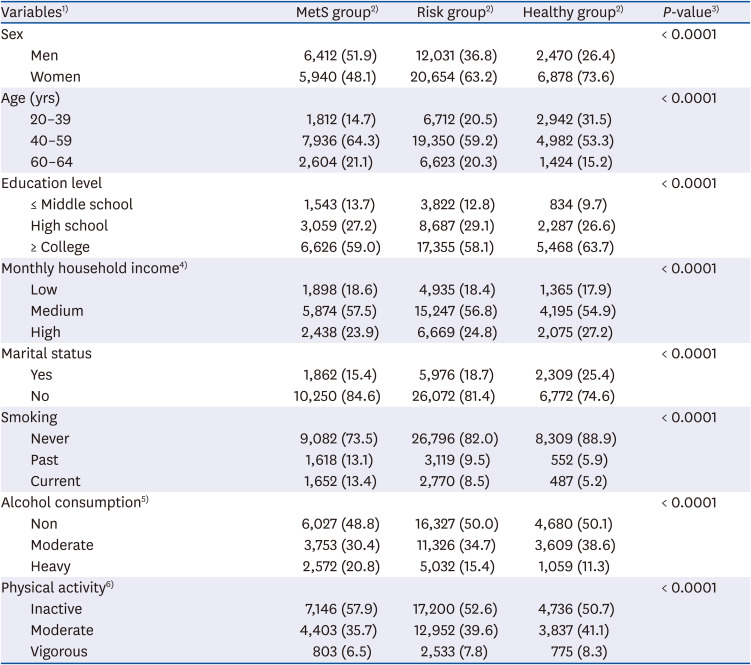
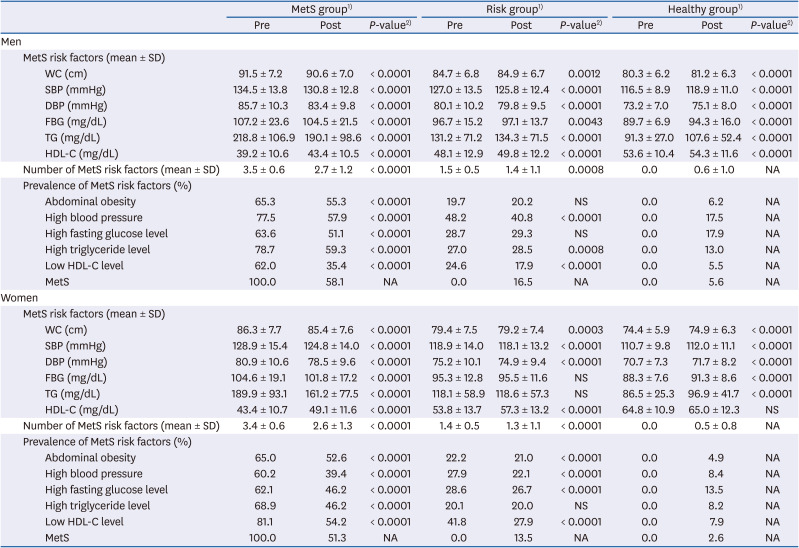
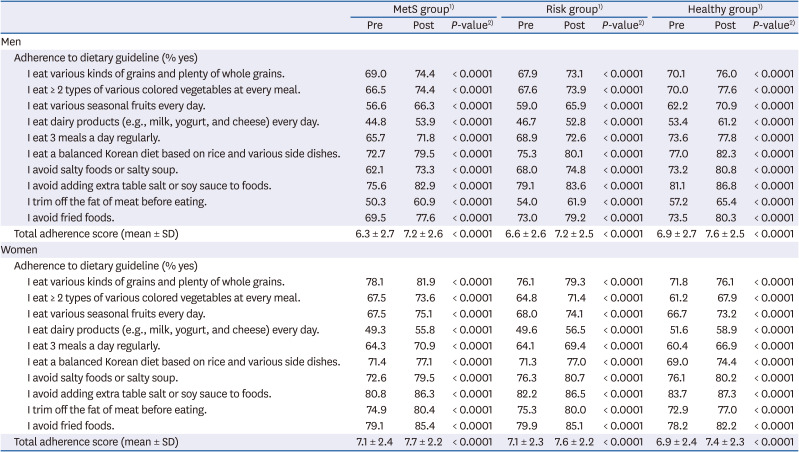
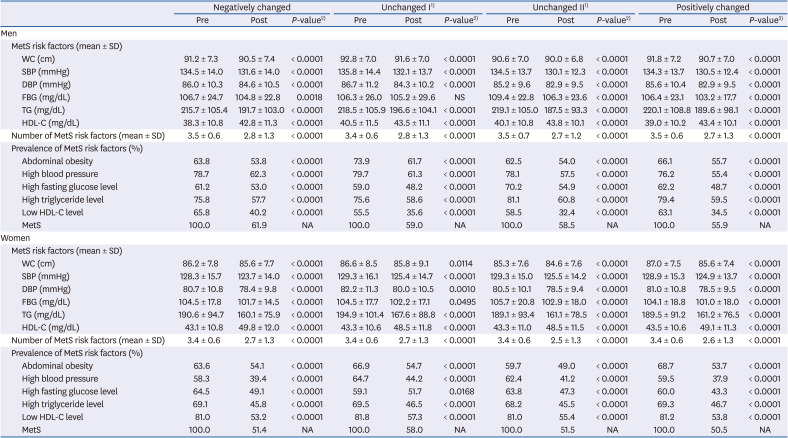
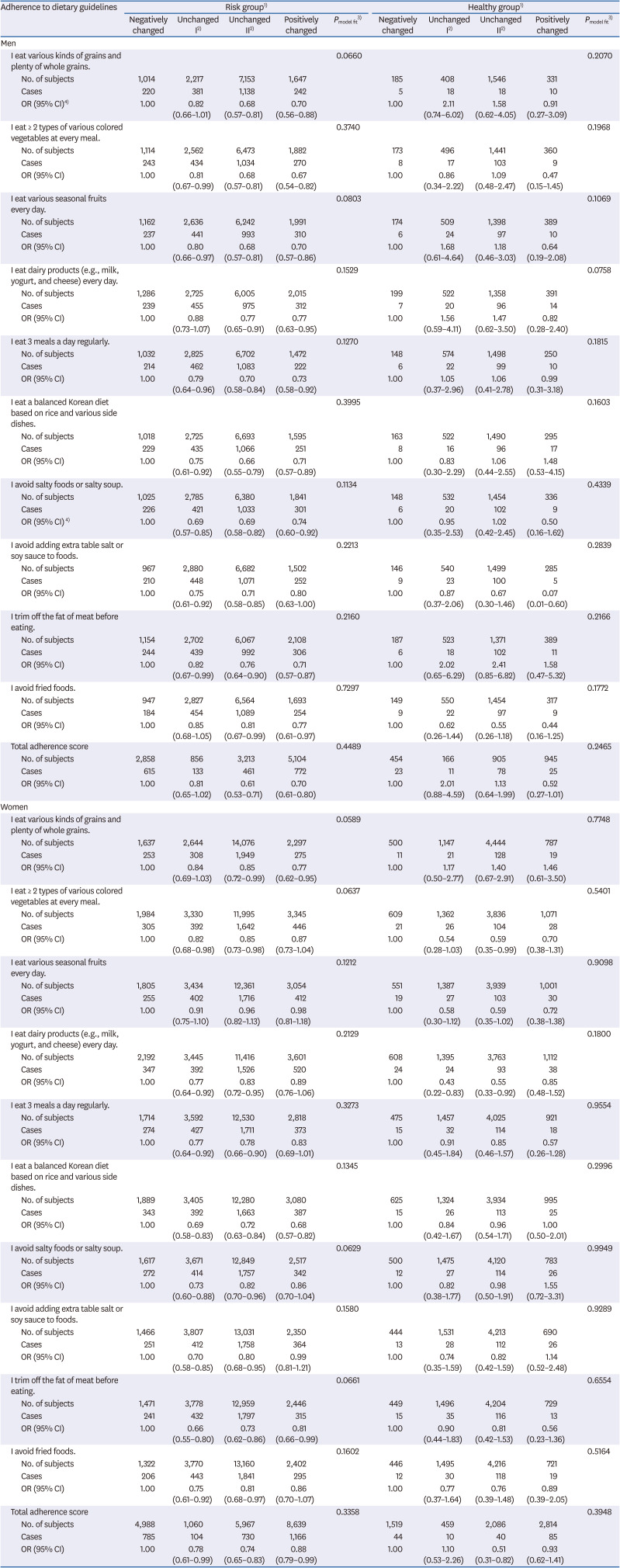




 PDF
PDF Citation
Citation Print
Print



 XML Download
XML Download